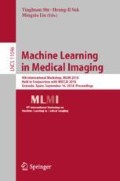Abstract
Accurate segmentation of medical images is an important step towards analyzing and tracking disease related morphological alterations in the anatomy. Convolutional neural networks (CNNs) have recently emerged as a powerful tool for many segmentation tasks in medical imaging. The performance of CNNs strongly depends on the size of the training data and combining data from different sources is an effective strategy for obtaining larger training datasets. However, this is often challenged by heterogeneous labeling of the datasets. For instance, one of the dataset may be missing labels or a number of labels may have been combined into a super label. In this work we propose a cost function which allows integration of multiple datasets with heterogeneous label subsets into a joint training. We evaluated the performance of this strategy on thigh MR and a cardiac MR datasets in which we artificially merged labels for half of the data. We found the proposed cost function substantially outperforms a naive masking approach, obtaining results very close to using the full annotations.
Access this chapter
Tax calculation will be finalised at checkout
Purchases are for personal use only
References
Shen, D., Wu, G., Suk, H.: Deep learning in medical image analysis. Annu. Rev. Biomed. Eng. 19(1), 221–48 (2017)
Prescott, J.W.: Quantitative imaging biomarkers: the application of advanced image processing and analysis to clinical and preclinical decision making. J. Digit. Imaging 26(1), 97–108 (2013)
Litjens, G., Kooi, T., Bejnordi, B.E., Setio, A.A.A., Ciompi, F., et al.: A survey on deep learning in medical image analysis. Med. Image Anal. 42, 60–88 (2017)
Ronneberger, O., Fischer, P., Brox, T.: U-net: convolutional networks for biomedical image segmentation. In: MICCAI, pp. 234–41 (2015)
Iglesias, J.E., Sabuncu, M.R., Aganj, I., Bhatt, P., Casillas, C., et al.: An algorithm for optimal fusion of atlases with different labeling protocols. NeuroImage 106, 451–63 (2014)
Peterfy, C.G., Schneider, E., Nevitt, M.: The osteoarthritis initiative: report on the design rationale for the magnetic resonance imaging protocol for the knee. Osteoarthr. Cartil. 16(12), 1433–41 (2008)
Bernard, O., Lalande, A., Zotti, C., Cervenansky, F., Yang, X. et al.: Deep learning techniques for automatic MRI cardiac multi-structures segmentation and diagnosis: is the problem solved? IEEE Trans. Med. Imaging (2018)
Ruhdorfer, A., Dannhauer, T., Wirth, W., Hitzl, W., Kwoh, C.K.: Cross-sectional and longitudinal side differences in thigh muscles. Arthr. Care Res. 65(7), 1034–42 (2013)
Ruhdorfer, A., Wirth, W., Dannhauer, T., Eckstein, F.: Longitudinal (4 year) change of thigh muscle and adipose tissue distribution in chronically painful vs painless knees - data from the osteoarthritis initiative. Osteo. Cartil. 23(8) 1348–56 (2015)
Cicek, Ö., Abdulkadir, A., Lienkamp, S.S., Brox, T., Ronneberger, O.: 3D U-Net: learning dense volumetric segmentation from sparse annotation. In: MICCAI, pp. 424–32 (2016)
Baumgartner, C.F., Koch, L.M., Pollefeys, M., Konukoglu, E.: An exploration of 2D and 3D deep learning techniques for cardiac MR image segmentation. In: Proceedings of the Statistical Atlases and Computational Models of the Heart (STACOM), ACDC Challenge, MICCAI17 Workshop (2017)
Kemnitz, J., Wirth, W., Eckstein, F., Culvenor, A.G.: The Role of Thigh Muscle and Adipose Tissue in Knee Osteoarthritis Progression in Women: Data from the Osteoarthritis Initiative. Osteo. Cartil. (2018) Epub ahead of print
Author information
Authors and Affiliations
Corresponding author
Editor information
Editors and Affiliations
Rights and permissions
Copyright information
© 2018 Springer Nature Switzerland AG
About this paper
Cite this paper
Kemnitz, J., Baumgartner, C.F., Wirth, W., Eckstein, F., Eder, S.K., Konukoglu, E. (2018). Combining Heterogeneously Labeled Datasets For Training Segmentation Networks. In: Shi, Y., Suk, HI., Liu, M. (eds) Machine Learning in Medical Imaging. MLMI 2018. Lecture Notes in Computer Science(), vol 11046. Springer, Cham. https://doi.org/10.1007/978-3-030-00919-9_32
Download citation
DOI: https://doi.org/10.1007/978-3-030-00919-9_32
Published:
Publisher Name: Springer, Cham
Print ISBN: 978-3-030-00918-2
Online ISBN: 978-3-030-00919-9
eBook Packages: Computer ScienceComputer Science (R0)

